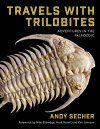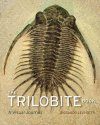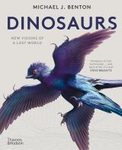By
Leon (NHBS Catalogue Editor)
25 Jul 2024
Written for Hardback

Following on from this 2022 book
Travels with Trilobites, fossil collector and trilobite enthusiast Andy Secher returns with
The Trilobite Collector's Guide. Leaning fully into his background as a long-time editor of hard rock magazine
Hit Parader, he here presents 52 chapters with top 10 lists that present a medley of trilobite facts and factoids. As before, this book is chock-a-block with many previously unseen colour photos of these fossilised arthropods, showcasing their tremendous morphological variation. In the spirit of this book, here are my top 10 observations on
The Trilobite Collector's Guide.
1. Let others sing your praises
Secher managed to snare no less than trilobite mastermind Richard J. Fortey, the former head of fossil arthropod research at the London NHM, and Melanie J. Hopkins, curator of fossil invertebrates at the AMNH to write a foreword. Hopkins provides her own top 10 reasons why you should read this book and nicely observes that "to be a truly great collector, however, is also to be an ambassador" (p. xiii). That describes Secher to a T.
2. Mind the collectors
For those who have bought Secher's previous book, rest assured that this one has the same dimensions and sports the same font on the cover. The two make a fine pair on your bookshelf.
3. Abundant alliteration and purple prose
More so than in his previous book, Secher leans heavily on alliteration. Scanning the table of contents, alliteration abounds: "10 Significant Silurian Trilobite Localities", "10 Eminently Elegant Trilobites", etc. In the text, too, Secher will not resist talking of "fossiliferous fascination" (p. v), "the trilobite line's tenacious trek through time" (p. 89) or websites such as eBay encouraging "auction action" (p. 307). He can occasionally go overboard on the purple prose, e.g. by describing collectors who are not intimidated by large numbers and controversial theories as people "willing to stare the great abyss of time squarely in its fanciful face" while they deal with "cerebrally challenging topics [and] scientifically scintillating theories" (p. 127). Secher is nothing if not enthusiastic, but it might not be everyone's cup of tea.
4. Location, location, location
Something that I have only been slow to realise is that much of what we have learned in palaeontology is intimately bound to very specific locations that provide a window into a very specific period in time. For each geologic period, he features 10 notable locations all around the world. Additional chapters highlight spectacular fossils from trilobite-hotbeds such as Morocco or Utah, or focus on famous quarries such as the Walcott/Rust quarry and Rochester Shale in New York State, or outcrops in Dudley, England.
5. No subject left behind
Next to the obvious top 10s with superlatives (the oldest, youngest, rarest, biggest, and most expensive fossils), the 52 chapters leave virtually no topic untouched. There are chapters on morphological aspects (enrollment, eyes, spines, disarticulated fragments, and soft tissue preservation), some very interesting chapters on practical aspects of the hobby (with top 10 tips on collecting, curating, preparing, and valuing your fossils), and chapters offering mini-reviews of the top 10 best books, websites, museums, and fossil shows.
6. Is more always better?
Tying in with the above observation, whether more is better is a fair question to ask. At 453 pages this is a long book and some chapters struggle to set themselves apart: is there really any difference between "10 Legendary Trilobites", "10 Strikingly Strange Trilobites", and "10 Deserving-of-Mention Trilobites"? Chapter 44, "10 Trilobite Orders", which lists 10 names for each order, feels like filler and could have offered a far more interesting summary of what sets each order apart from the other.
7. Lest we forget the science
Though collector interests take the lead in this book, there are sporadic injections of interesting science here. A recurrent theme is how similar or even identical trilobite species showing up in outcrops on different continents is a key observation in support of plate tectonics. Another theme is the fossilised evidence of behaviour such as enrollment or traces of predation.
8. What mad medley
As with his previous book, the aim has been to produce a "package of pure Paleozoic entertainment" (p. 5). Secher leans heavily on fast-paced, bite-size, listicle-style content. The topics are thoroughly mixed up and he bounces between them in no particular order, making the book more suitable for dipping into than reading in long sittings.
9. Opportunities missed
Overall I feel Secher has done a good job of presenting an accessible and entertaining collection of trilobite-themed facts but, in my opinion, there are some minor opportunities that he missed. I would have liked to see a better overview of commonly found body parts and fragments in the chapter "10 Tantalizing Trilobite Teasers". As before, the book features no references and thus has many generic and unverifiable statements about what scientists think or have disagreed about. At the other end, there are several scientific conventions that he does not explain: for instance, what do n. sp. or cf. in species names stand for? And how does the species concept work for fossils?
10. Thoughts on the photography
Finally, a word about the photography as I was rather critical of this in my last review. He has improved on it here. Somewhat. In his introduction, Secher clarifies that he is indeed the photographer. Not happy with the photos taken by a professional, he gave it a shot himself, "but I fully recognize my limitations behind the lens" (p. 7). This time around there has fortunately been no embarrassing inclusion of pixelated photos. Though many photos are nice and sharp, many are equally still notably grainy or partially out of focus. It is telling that the few photos contributed by others are noticeably better. Seeing that this is a book to be enjoyed for its visual content, I would have implored Secher to hire a professional photographer had I been his editor.
Overall,
The Trilobite Collector's Guide boils over with Secher's enthusiasm for trilobites and it is, I must admit, rather infectious. I have been eyeing up several further books after reading his top 10 recommendations. If you enjoyed his previous book, then buying this one is a no-brainer, especially given the huge amount of new photography. For those new to Secher or already in possession of other trilobite books I am a little bit more reserved in my recommendation. Given the book's idiosyncratic format of top-10 lists, occasionally iffy photography, and rather hefty price tag, you may first want to leaf through a copy in a bookshop if you have the opportunity.










































